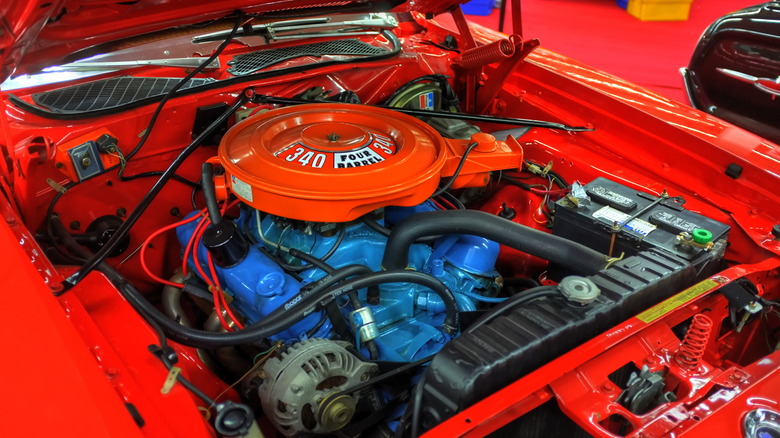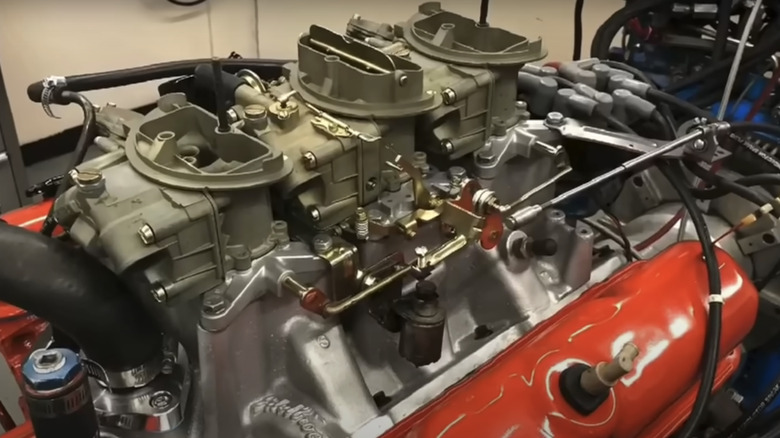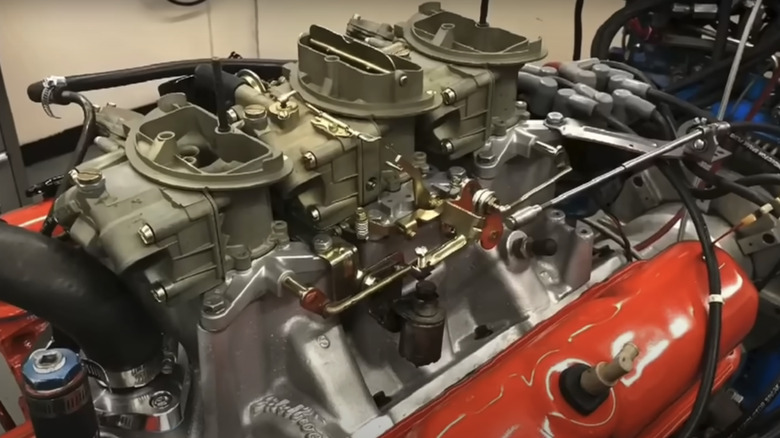The Best And Worst Years For The Mopar 340 Engine
When Chrysler invented antifreeze in 1937, it established the Mopar brand (a mashup of the words "motor" and "parts") to help sell its new product along with a larger line of car parts and accessories. The word has since become a catch-all for all of the products that fall under the Chrysler umbrella, from vehicles and the engines that power them to the parts and fluids that help keep those cars and trucks running. Initially, Mopar branding covered Chrysler, Dodge, Plymouth, and Desoto, but Desoto was scrapped in 1960, and Plymouth got the axe in 2001. Chrysler acquired Jeep and Eagle along with AMC in 1987, but only Jeep is still around today.
Fiat purchased Chrysler in 2009, and five years ago, Fiat Chrysler merged with PSA, the parent company of Peugeot and four other European brands. The newly merged group took the name Stellantis, leaving the badges of the original companies in place. Although Chrysler has gone from one of the United States' "Big Three" to just one piece of a massive international conglomerate, during its heyday during the 1960s and '70s, Chrysler made some of the auto industry's most desirable engines. Among those were more than a half-dozen variants of the bulletproof slant six and a lineup of 400-plus horsepower big block V8s dubbed the B series. During that same era, Chrysler also developed a series of small-block V8s with displacements ranging from 273 to 360 cubic inches.
The 340 was a performance beast
That small-block series of engines was given the "LA" designation, not because it originated in Los Angeles or Louisiana, but to differentiate it from the older A series which preceded the B-series big blocks. The L stood for both 'lower,' (meaning the deck height was below that of the original A series) and 'light,' as the LA engines were about 50 pounds lighter than their siblings. This was due to the LA series' thinner cylinder walls and updated heads and internal components. The first LA engine was the 273, which debuted in the Spring of 1964 under the hood of the upcoming 1965 Plymouth Barracuda and its A-body cousin, the Dodge Dart. A 318 cubic-inch version followed in 1967, and the 340 premiered the following year.
While the 273 and 318 were built to be efficient and economical to operate, the 340 was geared to performance. Chrysler advertised it as making 275 horsepower and 340 pound-feet of torque, but Hot Rod Magazine tested the 1968 340 at 320 horsepower and 368 pound-feet. Lowering the advertised numbers would have been a good way to help owners keep insurance costs down, a tactic that helped Chrysler sell more cars. When Hot Rod swapped out the stock manifold for headers, output jumped to 352.1 horsepower and 395.9 lb-ft of torque.
When they replaced the four-barrel carburetor with the "six-pack" configuration of three two-barrel carbs, Hot Rod measured 376.1 horsepower at 5,500 rpm and 408.9 lb-ft of torque.
1972 and '73 340 V8s were hobbled by emissions laws
Those numbers put the 340 ahead of the L79-powered Corvette, which boasted 350 horsepower and 360 pound-feet of torque. Unfortunately, the 340 peaked in its infancy. In 1970, six-pack versions of the Plymouth AAR Barracuda and Dodge Challenger T/A were released. Chrysler advertised these engines as producing 330 horsepower, but Muscle Car Club reports that number to be about 20 horses shy of what dyno tests reveal.
The 1968-70 360s had a compression ratio of 10.5:1, but that dropped to 10.25:1 in 1971 and plummeted to 8.5:1 in 1972 and '73 as emissions restrictions and the federal ban on leaded gasoline put the squeeze on muscle car production. The 340 died after the 1973 model year, but some of its parts lived on in the high-performance 360 that persisted. If you can find an original 1970 six-pack 340, you'll get high-performance cylinder heads, new valve covers, and stiffer bulkheads. You can identify these engines by the orange paint; Chrysler switched to blue late in the 1971 model year.


